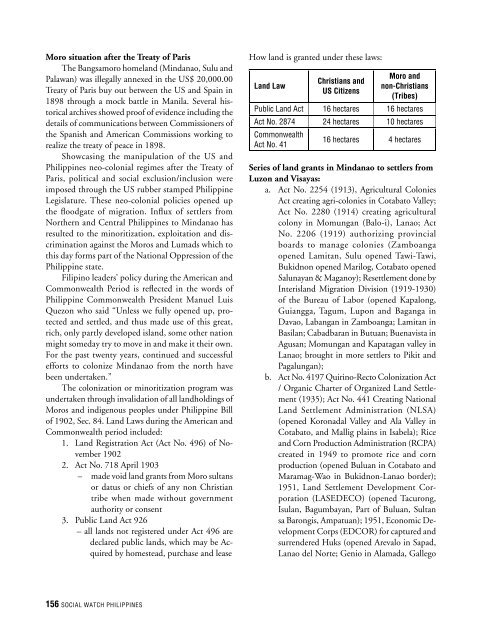Report - Social Watch Philippines
Report - Social Watch Philippines
Report - Social Watch Philippines
Create successful ePaper yourself
Turn your PDF publications into a flip-book with our unique Google optimized e-Paper software.
Moro situation after the Treaty of Paris<br />
The Bangsamoro homeland (Mindanao, Sulu and<br />
Palawan) was illegally annexed in the US$ 20,000.00<br />
Treaty of Paris buy out between the US and Spain in<br />
1898 through a mock battle in Manila. Several historical<br />
archives showed proof of evidence including the<br />
details of communications between Commissioners of<br />
the Spanish and American Commissions working to<br />
realize the treaty of peace in 1898.<br />
Showcasing the manipulation of the US and<br />
<strong>Philippines</strong> neo-colonial regimes after the Treaty of<br />
Paris, political and social exclusion/inclusion were<br />
imposed through the US rubber stamped Philippine<br />
Legislature. These neo-colonial policies opened up<br />
the fl oodgate of migration. Infl ux of settlers from<br />
Northern and Central <strong>Philippines</strong> to Mindanao has<br />
resulted to the minoritization, exploitation and discrimination<br />
against the Moros and Lumads which to<br />
this day forms part of the National Oppression of the<br />
Philippine state.<br />
Filipino leaders’ policy during the American and<br />
Commonwealth Period is refl ected in the words of<br />
Philippine Commonwealth President Manuel Luis<br />
Quezon who said “Unless we fully opened up, protected<br />
and settled, and thus made use of this great,<br />
rich, only partly developed island, some other nation<br />
might someday try to move in and make it their own.<br />
For the past twenty years, continued and successful<br />
efforts to colonize Mindanao from the north have<br />
been undertaken.”<br />
The colonization or minoritization program was<br />
undertaken through invalidation of all landholdings of<br />
Moros and indigenous peoples under Philippine Bill<br />
of 1902, Sec. 84. Land Laws during the American and<br />
Commonwealth period included:<br />
1. Land Registration Act (Act No. 496) of November<br />
1902<br />
2. Act No. 718 April 1903<br />
– made void land grants from Moro sultans<br />
or datus or chiefs of any non Christian<br />
tribe when made without government<br />
authority or consent<br />
3. Public Land Act 926<br />
– all lands not registered under Act 496 are<br />
declared public lands, which may be Acquired<br />
by homestead, purchase and lease<br />
156 SOCIAL WATCH PHILIPPINES<br />
How land is granted under these laws:<br />
Land Law<br />
Christians and<br />
US Citizens<br />
Moro and<br />
non-Christians<br />
(Tribes)<br />
Public Land Act 16 hectares 16 hectares<br />
Act No. 2874 24 hectares 10 hectares<br />
Commonwealth<br />
Act No. 41<br />
16 hectares 4 hectares<br />
Series of land grants in Mindanao to settlers from<br />
Luzon and Visayas:<br />
a. Act No. 2254 (1913), Agricultural Colonies<br />
Act creating agri-colonies in Cotabato Valley;<br />
Act No. 2280 (1914) creating agricultural<br />
colony in Momungan (Balo-i), Lanao; Act<br />
No. 2206 (1919) authorizing provincial<br />
boards to manage colonies (Zamboanga<br />
opened Lamitan, Sulu opened Tawi-Tawi,<br />
Bukidnon opened Marilog, Cotabato opened<br />
Salunayan & Maganoy); Resettlement done by<br />
Interisland Migration Division (1919-1930)<br />
of the Bureau of Labor (opened Kapalong,<br />
Guiangga, Tagum, Lupon and Baganga in<br />
Davao, Labangan in Zamboanga; Lamitan in<br />
Basilan; Cabadbaran in Butuan; Buenavista in<br />
Agusan; Momungan and Kapatagan valley in<br />
Lanao; brought in more settlers to Pikit and<br />
Pagalungan);<br />
b. Act No. 4197 Quirino-Recto Colonization Act<br />
/ Organic Charter of Organized Land Settlement<br />
(1935); Act No. 441 Creating National<br />
Land Settlement Administration (NLSA)<br />
(opened Koronadal Valley and Ala Valley in<br />
Cotabato, and Mallig plains in Isabela); Rice<br />
and Corn Production Administration (RCPA)<br />
created in 1949 to promote rice and corn<br />
production (opened Buluan in Cotabato and<br />
Maramag-Wao in Bukidnon-Lanao border);<br />
1951, Land Settlement Development Corporation<br />
(LASEDECO) (opened Tacurong,<br />
Isulan, Bagumbayan, Part of Buluan, Sultan<br />
sa Barongis, Ampatuan); 1951, Economic Development<br />
Corps (EDCOR) for captured and<br />
surrendered Huks (opened Arevalo in Sapad,<br />
Lanao del Norte; Genio in Alamada, Gallego


